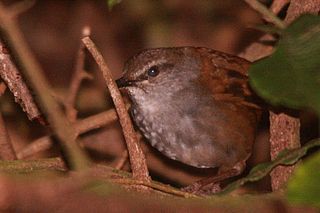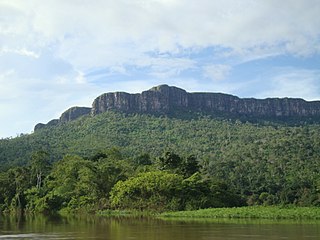
The Solomon Islands rain forests are a terrestrial ecoregion covering the Solomon Islands archipelago.

Wallacea is a biogeographical designation for a group of mainly Indonesian islands separated by deep-water straits from the Asian and Australian continental shelves. Wallacea includes Sulawesi, the largest island in the group, as well as Lombok, Sumbawa, Flores, Sumba, Timor, Halmahera, Buru, Seram, and many smaller islands. The islands of Wallacea lie between the Sunda Shelf to the west, and the Sahul Shelf including Australia and New Guinea to the south and east. The total land area of Wallacea is 347,000 km2 (134,000 sq mi).

Lore Lindu National Park is a protected area of forest on the Indonesian island of Sulawesi, in the province of Central Sulawesi. The Indonesian national park is 2,180 km2 covering both lowland and montane forests. It provides habitat to numerous rare species, including 77 bird species endemic to Sulawesi. The national park is designated as part of the UNESCO World Network of Biosphere Reserves. In addition to its rich wildlife, the park also contains megaliths dating from before 1300 AD.

The Sulawesi bush warbler is a species of Old World warbler in the family Locustellidae. It is endemic to the island of Sulawesi in Indonesia where it is found on the forest floor.

The golden-mantled racket-tail is a species of parrot in the family Psittaculidae. It is endemic to Indonesia. Its natural habitats are subtropical or tropical moist lowland forest and subtropical or tropical moist montane forest up to an altitude of about 3,000 metres (9,800 ft).

The Sulawesi masked owl is a species of owl in the family Tytonidae. It is endemic to the Indonesian islands of Sulawesi, Sangihe and Peleng. It is listed by the IUCN as being of least concern.

The scaly-breasted kingfisher or regent kingfisher is a species of bird in the family Alcedinidae endemic to central and southwestern Sulawesi in Indonesia. Its natural habitat is subtropical or tropical, moist, montane forests.

The cerulean cuckooshrike is a species of bird in the family Campephagidae. It is endemic to the island of Sulawesi in Indonesia. Its natural habitats are subtropical or tropical moist lowland forest and subtropical or tropical moist montane forest. Other common names for this bird include the Sulawesi cuckooshrike, the Celebes cuckooshrike and Temminck's cuckooshrike.

The Matinan blue flycatcher, also known as the Matinan flycatcher, is a species of bird in the family Muscicapidae. It is endemic to the island of Sulawesi in Indonesia. Its natural habitat is subtropical or tropical moist montane forests, and the species is threatened by habitat loss.

The dark-eared myza, also known as the lesser streaked honeyeater, is a species of bird in the family Meliphagidae. It is endemic to the island of Sulawesi in Indonesia. There are two subspecies, Myza celebensis celebensis which is found in mountainous parts of northern, central and southeastern Sulawesi, and Myza celebensis meridionalis from mountains in southern Sulawesi.

The Borneo lowland rain forests is an ecoregion, within the tropical and subtropical moist broadleaf forests biome, of the large island of Borneo in Southeast Asia. It supports approximately 15,000 plant species, 380 bird species and several mammal species. The Borneo lowland rain forests is diminishing due to logging, hunting and conversion to commercial land use.

Bunaken National Park is a marine park in the north of Sulawesi Island, Indonesia. The park is located near the centre of the Coral Triangle, providing habitat to 390 species of coral as well as many fish, mollusks, reptiles and marine mammal species. The park is representative of Indonesian tropical water ecosystems, consisting of seagrass plains, coral reefs and coastal ecosystems.

The Biak–Numfoor rain forests is a tropical moist forest ecoregion in Indonesia. The ecoregion covers the islands of Biak, Supiori, Numfoor, and several smaller islands, which lie in Cenderawasih Bay north of Yapen and New Guinea.

The Central Range montane rain forests is a tropical moist forest ecoregion on the island of New Guinea. The ecoregion covers the Central Range of the New Guinea Highlands, which extends along the spine of the island. The montane rain forests of the ecoregion are distinct from the surrounding lowland forests, and are home to many endemic plants and animals.

The Borneo montane rain forests is an ecoregion on the island of Borneo in Southeast Asia. It includes montane tropical and subtropical moist broadleaf forests, also known as a cloud forests. The ecoregion is partly in East Malaysia and Indonesia (Kalimantan).

Tangkoko Batuangus Nature Reserve, Indonesian: Tangkoko-Batuangus Dua Saudara is a nature reserve in the northern part of Sulawesi island of Indonesia, 70 kilometres from Manado City. The reserve covers an area of 8,718 hectares, and includes three mountains: Mount Tangkoko at 1,109 metres, Mount Dua Saudara at 1,361 metres, and Mount Batuangus at 450 metres.

The Guayanan Highlands moist forests (NT0124) is an ecoregion in the south of Venezuela, the north of Brazil, and also within Guyana, Suriname, and French Guiana. It is in the Amazon biome. It encompasses an upland region with diverse fauna and flora, which contains dramatic tepuis, or sandstone table mountains. The region has been inaccessible in the past and is generally fairly intact, apart from the north and northeast where large scale agriculture, ranching and mining operations are steadily encroaching on the ecosystem. New roads are opening the interior to logging, and planned dams will have a drastic impact on the riparian zones.

The Sulawesi lowland rain forests is a tropical moist forest ecoregion in Indonesia. The ecoregion includes the lowlands of Sulawesi and neighboring islands.

The Sulawesi montane rain forests is a tropical moist forest ecoregion in Indonesia. It includes the highlands of Sulawesi.

The Yapen rain forests is a tropical moist forest ecoregion in Indonesia. The ecoregion covers the island of Yapen and smaller neighboring islands which lie north of New Guinea.



















